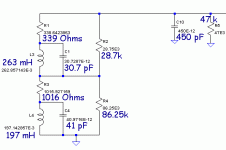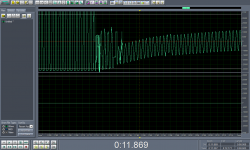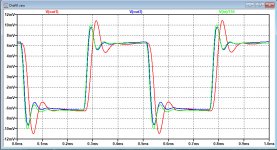Clipping usually means breaking the feedback loop which could lead to most unwanted recovery problems.
However when using opamps, many of them nowadays are well armed against phase reversal and the so called TI soundplus opamps have excellent soft clipping mechanisms for as far I could measure.
So I rather would prefer to do the clipping as soon but as smooth as possible.
And I agree with Pavel that the first stage is the best place to start attenuating the plops and clicks actively instead of using a passive filter behind the first stage.
When simulating you will see an astonishing difference in favour of the active version.
Alternatively the 75u pole loading of the cart to keep the plops and clicks from the first stage will have similar effect in case of using an MM
Hans
I don't get it, the first part seems to contradict the second part. Do you prefer (soft) clipping before RIAA correction or no clipping at all?
And this is what things are becoming when replacing the 75usec pole behind the first OPA by a lower termination resitance.
R = L/Tc = 0.46/75usec = 6k13
This 6K13 minus the 1k35 fron the Cart gives 4k783 as a termination load.
Because of this, the FR will significantly change in the HF area, so C9 will have to be increased to 2n5.
In the image below you will see again the FR without Cart mechanical resonance in red and after Cart resonance in Blue.
FR will now be practically insensitive to the input capacitance.
Hans
I never saw the point in having a damped mode without inverse resonant filter, but what you show here is that you can turn the cartridge mechanical resonance plus an extra first-order roll-off into a sort of third-order Chebyshev low-pass filter. With the conventional approach, it is always fourth order, so this could very well lead to a better step response than the conventional approach.
Do you indeed get an improved step response or is it rather similar because the pole pair with the highest Q stays as is?
Would I be abusing your courtesy if I asked you to put all the values in non-scientific notation?
It's not even Scientific Notation, it is Engineering Notation. It goes by thousands. "E3" is k. "E-3" is milli. Transposition is quite trivial.
Attachments
What do you mean by Rs +? Series resistor and clamp after the amplifier with RIAA correction?
Yes, behind the phono preamp. Because though useful output of the phono preamp under normal working conditions would be below 1V, in case of clicks the phono preamp output peak voltage is in several Volts and this overloads an input of the following preamp or integrated amplifier. The behaviour of the audio chain in case of vinyl clicks or mistracking then completely depends on recovery time of the connected preamp or integrated amplifier and this recovery behaviour is often far from optimum. So, the output of the phono preamp to be limited to some 2Vpeak or less, this might be a subject of discussion.
Has anyone analysed a pathalogical click in terms of phono output post RIAA correction? Scott mentioned that most decent ADCs recover very quickly from an overload in his testing, but I haven't checked that on the ADC I will be using.
Good idea, I will try some soundcards.
However, I KNOW that some integrated amplifiers clip, not nicely, at input level close to 2.8Vp and this can be easily exceeded.
However, I KNOW that some integrated amplifiers clip, not nicely, at input level close to 2.8Vp and this can be easily exceeded.
To show the differences between alternative topologies I have simulated three Riaa versions using a 460mH + 1350R Cart including it's simulated mechanical resonance.
This Cart is producing a click while using a two stage preamp.
The second stage has 20dB gain@1Kz
1) Flat first preamp with a passive 75usec pole after this first amp, like Carlmart has proposed.
2) 75usec pole in the first amp's feedback loop.
3) 75usec pole created by terminating the Cart with 4k78.
In that order you will see in the upper left part of the image image the output signals Out1 to Out3.
Apart from some differences in time delay, they are all equal and Out1 and Out2 are on top of each other.
Then looking at the output signal coming from the first stage at the lower left part.
-With Amp1, the flat amp, signal is almost 14dB stronger as in
-Amp2 where the pole was created in the feedback loop.
-Amp3 is comparable in amplitude to Amp2.
But with a gain of the second stage of 20dB@1Khz, in situation 1) both stages will then have to cope with almost the same click amplitude peak.
So when reducing the click amplitude with a feedback cap or a 75usec Cart termination, the clipping problem will be fully transferred to the second amp.
But intuitively I would still prefer situation 2) or 3) and try to make a much easier soft clipping provision around the second amp.
Hans
This Cart is producing a click while using a two stage preamp.
The second stage has 20dB gain@1Kz
1) Flat first preamp with a passive 75usec pole after this first amp, like Carlmart has proposed.
2) 75usec pole in the first amp's feedback loop.
3) 75usec pole created by terminating the Cart with 4k78.
In that order you will see in the upper left part of the image image the output signals Out1 to Out3.
Apart from some differences in time delay, they are all equal and Out1 and Out2 are on top of each other.
Then looking at the output signal coming from the first stage at the lower left part.
-With Amp1, the flat amp, signal is almost 14dB stronger as in
-Amp2 where the pole was created in the feedback loop.
-Amp3 is comparable in amplitude to Amp2.
But with a gain of the second stage of 20dB@1Khz, in situation 1) both stages will then have to cope with almost the same click amplitude peak.
So when reducing the click amplitude with a feedback cap or a 75usec Cart termination, the clipping problem will be fully transferred to the second amp.
But intuitively I would still prefer situation 2) or 3) and try to make a much easier soft clipping provision around the second amp.
Hans
Attachments
1)
3) What output values ??
L1, C3 and R4: do they need to be added to the actual schematic or are used only here for simulation purposes?
Particularly L1 and C3.
I don't get it, the first part seems to contradict the second part. Do you prefer (soft) clipping before RIAA correction or no clipping at all?
If possible I prefer no hard clipping at all.
But If the signal can become larger as the amp can cope with, I prefer soft clipping where the feedback loop stays intact.
Looking at the previous post, it's way easier to provide the second stage with a soft clipping mechanism with a few additional components and keep the signal in the first stage small.
Preferably the soft clipping in the second stage should start at a level comparable to a CD signal.
That will prevent the preamp and the main amp hereafter having to deal with clipping.
Hans
We have two extremes in my mind.
1. completely flat for archiving
2. use the cartridge to create a first order electrical roll off
Both should be able to be made to work well, but is there a winner in the performance stakes?
1. completely flat for archiving
2. use the cartridge to create a first order electrical roll off
Both should be able to be made to work well, but is there a winner in the performance stakes?
L1, C3 and R4: do they need to be added to the actual schematic or are used only here for simulation purposes?
Particularly L1 and C3.
Only for the simulation purpose to emulate the Cart's mechanical resonance.
Hans
We have two extremes in my mind.
1. completely flat for archiving
2. use the cartridge to create a first order electrical roll off
Both should be able to be made to work well, but is there a winner in the performance stakes?
I would say to always implement the 75usec pole which could be very well done by properly terminating the Cart creating a 75usec pole.
This will be a big relief in for the ADC/DSP that will only have to deal with the two other poles of 3180 and 318usec.
Hans
Those diodes in the circuit are simply to ensure the the circuit clips cleanly and doesn’t suffer from overhang. You see them many power amps and discreet preamplifiers. Quite why they’re ‘special’ here, or specific to RIAA escapes me.
Most of the click and pop energy is well above 2kHz where the RIAA gain is falling at 20 dB/decade and any decent phono amp will have >20 dB overload capability so it should be a none issue on a FB design.
Designs that put a flat gain stage up front (really suboptimal thing to do IMV) suffer from limited overload capability and these are likely to hit the buffers on a bad click/pop.
Most of the click and pop energy is well above 2kHz where the RIAA gain is falling at 20 dB/decade and any decent phono amp will have >20 dB overload capability so it should be a none issue on a FB design.
Designs that put a flat gain stage up front (really suboptimal thing to do IMV) suffer from limited overload capability and these are likely to hit the buffers on a bad click/pop.
Using the cart L to create the first pole means you have to accurately know the cart L so this lends itself to specialist systems ie its not a general solution capable of handling a wide range of carts.
Designs that put a flat gain stage up front (really suboptimal thing to do IMV) suffer from limited overload capability and these are likely to hit the buffers on a bad click/pop.
Thereby reducing the volume of the click/pop. That may be undesired when you want to digitize the signal and apply some digital declicking algorithm, but is it also undesired when you just want to listen to the record?
@Bonsai,
I don’t think this is difficult to implement and after all this is a DIY forum, right?
But a first stage with the 75usec pole in the feedback loop will be just as effective.
Hans
I don’t think this is difficult to implement and after all this is a DIY forum, right?
But a first stage with the 75usec pole in the feedback loop will be just as effective.
Hans
Last edited:
This clicks and pops problem seems to have grown and developed into options I'm not sure how to deal with.
My experience is limited to one setup, that I will describe, and only one pair of LPs, that had not been extensively used but were not washed, and I think should have been, for the actual capture.
The turntable was a Thorens TD150, with Linn Basik LVX arm, Shure V15 III cartrdige, fed into a Luxman 5C50 RIAA preamp. The load had been adjusted using LP test record and scope.
This was fed into a Beheringer UCA202 16bit/48KHz ADC, and recorded on my laptop.
The files were then processed with Audacity, working on the individual curves and cleaning each click/pop one by one. Audacity has a very sophisticated and effective way to do that, removing the clicks surgically and leaving the very short space filled with what seemed a very very short piece of what after or before the click. Some prefer to draw a reconstructed curve. I tried both methods and the automatic was better and accurate.
I found the audible results completely perfect, with nothing except the music to listen to. PMA comments that the clicks cause a distortion in the captured audio surprised me, very logical as they were and to be expected, because if there was any post-click distortion I didn't hear it.
We didn't yet try to compare the recording with the actual LP, in an AB comparison. My friend's system is an extremely accurate one. He designs high quality speakers, so this is the system he uses for his tests, his main listening room.
Next time I will take my Tascam DR70, which I think is better than the Behringer I used, and do some recording tests @ 24/96, comparing things immediately and with another LP.
Problem is next time might take more than a year, if we are lucky, with this pandemic.
My experience is limited to one setup, that I will describe, and only one pair of LPs, that had not been extensively used but were not washed, and I think should have been, for the actual capture.
The turntable was a Thorens TD150, with Linn Basik LVX arm, Shure V15 III cartrdige, fed into a Luxman 5C50 RIAA preamp. The load had been adjusted using LP test record and scope.
This was fed into a Beheringer UCA202 16bit/48KHz ADC, and recorded on my laptop.
The files were then processed with Audacity, working on the individual curves and cleaning each click/pop one by one. Audacity has a very sophisticated and effective way to do that, removing the clicks surgically and leaving the very short space filled with what seemed a very very short piece of what after or before the click. Some prefer to draw a reconstructed curve. I tried both methods and the automatic was better and accurate.
I found the audible results completely perfect, with nothing except the music to listen to. PMA comments that the clicks cause a distortion in the captured audio surprised me, very logical as they were and to be expected, because if there was any post-click distortion I didn't hear it.
We didn't yet try to compare the recording with the actual LP, in an AB comparison. My friend's system is an extremely accurate one. He designs high quality speakers, so this is the system he uses for his tests, his main listening room.
Next time I will take my Tascam DR70, which I think is better than the Behringer I used, and do some recording tests @ 24/96, comparing things immediately and with another LP.
Problem is next time might take more than a year, if we are lucky, with this pandemic.
Last edited:
I never saw the point in having a damped mode without inverse resonant filter, but what you show here is that you can turn the cartridge mechanical resonance plus an extra first-order roll-off into a sort of third-order Chebyshev low-pass filter. With the conventional approach, it is always fourth order, so this could very well lead to a better step response than the conventional approach.
Do you indeed get an improved step response or is it rather similar because the pole pair with the highest Q stays as is?
Yes, damping has indeed improved the step response, see below.
In the image you see V(out1) for the straightforward version, the damped version as V(out3) and the the anti riaa's input signal as V(in).
Hans
Attachments
- Status
- Not open for further replies.
- Home
- Source & Line
- Analogue Source
- FET vs BJT input phono preamp



